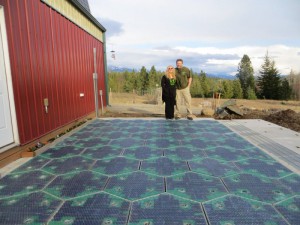 Around 8 years ago, Julie and Scott Brusaw from Idaho started throwing around the concept to replace the asphalt on current parking lots, driveways, streets and eventually highways throughout the US with solar panels that generate electricity and were tough enough to be driven upon.
Around 8 years ago, Julie and Scott Brusaw from Idaho started throwing around the concept to replace the asphalt on current parking lots, driveways, streets and eventually highways throughout the US with solar panels that generate electricity and were tough enough to be driven upon.
Their project Solar Roadways is a modular paving system made of solar hexagonal photovoltaic segments covered with textured glass. The cells are toughened enough to withstand 250,000 pounds and feature embedded lighting to act as road markings and warnings and could be heated to prevent snow and ice build-up. Made from recycled materials, the photovoltaic panels generate renewable energy. Collected power depends on the quantity of received sunshine so the system will produce more energy in some parts of the country than others.
The project won first prize in two of GE’ s Ecomagination challenges and Solar Roadways has received two phases of funding from the US Federal Highway Administration for research and development. However, the Brusaws are asking for another $1 million to hire scientists and engineers that will turn the Solar Roadways from neat idea to workable project. But some calculations show that the total coast to replace the US roadways with solar panels would be $56 trillion, that’s about four times the country’s national debt.
Obviously, there are some questions raised such as: will heating the ground to keep the roadways clear cause more climate change and how to store the energy or how to keep the surface clean.
A crazy idea or not, perhaps Solar Roadways could happen to be the key to the next stage of roads’ evolution.